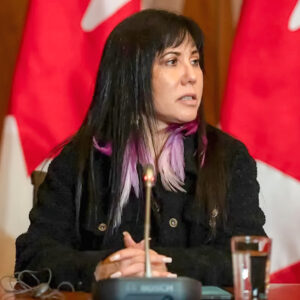
OHSWEKEN — A lawsuit against members of the Haudenosaunee Development Institute (HDI) was launched on Monday when HDI President Brian Doolittle was served legal papers outlining a series of charges against himself as an executive member of the HDI and 2438543 Inc.
Elvera Garlow and Aaron Detlor, also known as Robert Aaron Detlor, were served their papers on Tuesday by legal consultant, Lannie Henderson. The other named defendant in the case had not been served at press time.
The Class Proceeding allegations include Breach of Contract and Breach of Fiduciary Duty; Breach of Duties of the Haudenosaunee Development Institute; Civic Conspiracy; Conversion; Unjust Enrichment; and Breach of Trust, all totalling more than $100 million in damages.
Statement of Claim (Court File No. 16-58391)
Although launched by Davie and Monture, the 23-page statement of claim is on behalf of the HCCC — meaning, the People of Six Nations of the Grand River Territory.
Under the Class Proceedings Act, 1992, c6, “Class” or “Class Members” refer to approximately 25,000 Haudenosaunee people and individuals encompassing the “HCCC”, under the understanding that the Confederacy is in fact, the people and not the sitting Chiefs who are only the spokes people for their Clans.
The claim is calling for an immediate stop to any and all negotiations made by the HDI and for all funds be frozen in a trust account to be managed and administrated by a yet to be established board made up of rank and file Haudenosaunee People.
Lannie Henderson, who is connected with an organization known as the Native Supreme Council (NSC), will be acting as legal advisor to plaintiffs Wilfred Davey and Bill Monture — who have launched the suit.
According to the organization’s website, the NSC says they are free of any religious, or governmental affiliation.
The group was recently created with a mandate to protect Indigenous people and to promote the culture of ancient civilizations while implementing their morals into modern times.
NSC was brought in at the request of the Men’s Fire and others to review the works of the HDI.
The Men’s Fire, a Six Nations grassroots watchdog organization, has been trying to access information regarding the workings of HDI’s finances and who is making what from the several land usage deals the HDI has negotiated with energy companies.
Although HDI says their financial statements have been published on their website, criticisms ave been raised by Haudenosaunee people at Six Nations that the reports are too general and do not go into any sort of detailed explanation as to exactly where the money is going.
Despite HDI insisting they have been totally transparent with their financial disclosures, some community members believe they have been met with nothing but stone walls, secrecy and a complete lack of openness when asking for information about how the HDI is run, and how the money is spent.
Additional concerns have been raised that publisher/editor for a community newspaper on Six Nations, the Turtle Island News, is a paid media liaison for the HDI — raising questions in the community about the neutrality published in the Turtle Island News about the HDI.
Other areas of concern raised include the signing of two engagement agreements with Samsung in which the HDI agreed to, on behalf of the HCCC and the Haudenosaunee People, waive Haudenosaunee sovereignty immunity and any other claim or traditional treaty rights surrounding Haudenosaunee Land that the projects are utilizing in exchange for financial compensation.
According to the plaintiffs, members of the HDI never presented nor obtained approval from the HCCC for the Samsung deal before it was signed.
According to the claim, HDI was formed to function and operate in accordance with Haudenosaunee Law. Further, HDI was tasked with the responsibility of establishing a process and structure that protects the rights of Haudenosaunee People.
The creation by Detlor, Brian Doolittle and Hazel Hill of the numbered company 248543 Ontario Inc. and Ogwawigsta Inc. is also being brought into question in the claim, accusing them of doing so to divert funds properly belonging to the Haudenosaunee People.
The plaintiffs also state that defendant Elvera Garlow created a numbered corporation; namely Ogwawihsta to divert funds belonging to the HCCC and the Haudenosaunee People.
The plaintiffs claim HDI breached its fiduciary duties to the HCCC and the Haudenosaunee People to act diligently, with honesty and integrity and in the utmost good faith or the benefit of HCCC and the Haudenosaunee People.
The claim states that in or about 2009, the HCCC retained Aaron Detlor to act as their lawyer in exchange for financial compensation to the Haudenosaunee People.
Among others, Articles of the Retainer Agreement between the Haudenosaunee and Detlor laid out several terms of conduct and expectation, including no conflict of interest while under contract.
But at that same time Detlor was also contracted by the Whitefish Lake First Nation on a $14,000 per month retainer plus all travel and expenses, including a “success fee of 6.5 per cent of any financial settlement on a multimillion dollar case.
Detlor personally received $1.4 million for his part in that action.
A third party law firm’s review of Detlor’s Whitefish contract was requested by then Chief Steve Miller, which showed a number of questionable billing practices and a total lack of accountability.
Requests by Six Nations residents to review the contract he signed with the HCCC has been met with stone walling and silence.
The claim goes on to say that there was a promise made to the people by Detlor and the HDI that they would promptly share with the Haudenosaunee People the knowledge, information and documents which it had or which were available to it concerning any and all negotiations with developers, individuals or governments with respect to Land Use Agreements. This has not taken place.
A Civil Conspiracy has also been alleged in the action stating that the named defendants conspired together creating an interrelated web of corporations, businesses and individuals, the plaintiffs say, while communicating fraudulent and/or negligent misrepresentations with respect to the Samsung deals, accusing those involved in the alleged “conspiracy” with using this network to divert funds.
In following the money, the plaintiffs allege that the defendants wrongfully interfered with the funds of the HCCC and the Haudenosaunee People in a manner inconsistent with the right of possession by taking possession of the funds and dealing with them, creating a further breach of trust.
They are calling for an independent third party audit of all transactions done by Detlor and the HDI between January 2006 and August of 2016.
The plaintiffs have asked that the trial on these and other associated matters take place in Hamilton Court.
The plaintiffs are represented by James A. Brown of Burns Associates Barrister and Solicitors of Hamilton.
None of these allegations have been proven in a court of law.
What is a class action?
A class action is a civil lawsuit brought by one or more representative plaintiffs on behalf of a larger group of persons (the class members). A class action attempts to have common or similar claims resolved in a single proceeding with the result binding upon all class members and opposing parties.
When Are Class Actions Preferable to Individual Actions?
Where multiple plaintiffs are similarly situated, a class action eliminates the need to participate in repetitive and costly hearings and individual suits. In cases where it would not be economical or practical for an individual to bring a claim and multiple claimants are similarly affected, it may be viable to proceed as a class action.
When does an Action Become a Class Action?
In Ontario, a matter which is started as a class proceeding requires an Order for Certification from the Court certifying it as a class action.
What is Certification?
At the certification stage the court will consider whether there is a cause of action and identifiable class, whether common issues are raised, whether a class action is preferable for the resolution of common issues and whether there is a suitable representative plaintiff. Then, if the Court believes a class action is appropriate it will certify the action.
Who is the Representative Plaintiff?
The representative plaintiff is a class member who represents the entire class in the action. The representative plaintiff must fairly and adequately represent the interests of the class, not have an interest in conflict with other class members, and have a plan for pursuing the action (prepared by the lawyers) and notify class members. Representative plaintiffs take on greater rewards and risks than other class members and they must discuss those with a lawyer.
What Happens After Certification?
Traditionally, a very large number of class actions that get certified end up settling. However, if a settlement is not reached the action will proceed in the manner of a traditional lawsuit and move towards resolution of the common issues by a trial before a judge.
via thomsonrogers.com









wth?? i not sure what this is about but why is these people or person claiming the crown courts to have say over us???? to be used against the haudenoshonni?? idk maybe not haudenoshonni if running to the crown or leaving the canoe idk??????..i too am not part of the said 25,00 haudenoshonni in the class law suit thing i try an stay away from the crown … this action thing is taking away from our coming faces`es vioce an giving it to the crown to have the say enit!! an will not be part of destroying my people like that as it stand now..
so wheres the list to sign that you do not wish to be one of these
25,000 haudenosaunee
wilf or bill does not speak for me or my clan!!!!!
i never gave these retards any permission to speak for my clan or myself!!!!
assumption and presumption on there part is found to be slanderous and bullying the people to follow these idiots or they threaden you with a nightly visit to change your mind !!! what ever that means?????